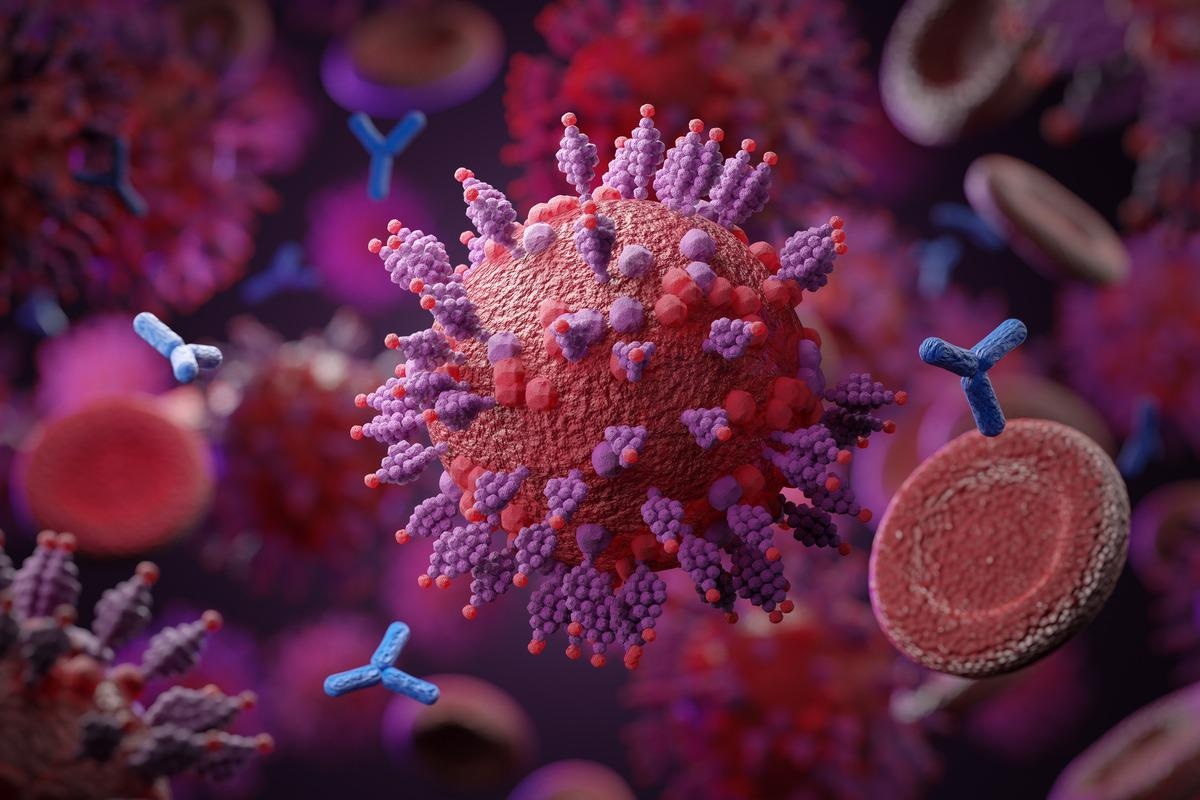Recently, a rapidly increasing variant of severe acute respiratory syndrome coronavirus 2 (SARS-CoV-2) emerged in the Gauteng province of South Africa, named Pangolin B.1.1.529 (Omicron). Omicron, which swiftly replaced the circulating Delta and other variants, harbors as many as thirty-two notable mutations in the spike protein. It was reported that the new variant was identified two months after its emergence – in late November 2021. By the 8th of December, this pathogen spread globally – spanning 50 countries with genome surveillance capacity.
The Omicron spread in South Africa remained steadily low before the new variant replaced the Delta variant. The reason behind the new epidemic can be explained via investigating the transmissibility of the Omicron variant.
 Study: Relative Reproduction Number of SARS-CoV-2 Omicron (B.1.1.529) Compared with Delta Variant in South Africa. Image Credit: Fit Ztudio/Shutterstock
Study: Relative Reproduction Number of SARS-CoV-2 Omicron (B.1.1.529) Compared with Delta Variant in South Africa. Image Credit: Fit Ztudio/Shutterstock
A recent study published in the Journal of Clinical Medicine presented a modeling result from an analysis of genome surveillance data in Gauteng province, South Africa, using an existing estimation technique.
The study
Here, genome surveillance data of Gauteng province as registered to Global Initiative on Sharing Avian Influenza Data (GISAID) as of the end of November 2021, was utilized. The study assumed that the effective reproduction number of the Omicron variant – Romicron(t), could be deduced by multiplying a constant factor k to that of Delta variant – Rdelta(t). Thus, a relationship Romicron(t) = kRdelta(t). Multinomial distribution was employed for maximum likelihood estimation of unknown parameters. Predicted and observed fractions of Omicron, Delta and other variants were compared – from September until November 2021.
The present study was primarily funded by the Japan Agency for Medical Research and Development, among others.
Findings
The results showed that Romicron(t) was 4.2 times greater than that of the Delta variant, while the effective reproduction number of other variants was estimated as 1.3 times greater. On estimating the relative exponential growth rate from October-November 2021, the Omicron variant elicited 3.3 times higher transmissibility than the Delta variant.
Transmission advantages of Omicron
Supposing ω was the fraction immune at the beginning of the ongoing epidemic in South Africa and €delta(t) was the time-dependent relative risk reduction due to acquired immunity against the Delta variant. Therefore, Rdelta(t) = (1 − €delta(t)ω)R0,delta, where R0,delta is the basic reproduction number of the Delta variant—which may be on the order of five or six during the winter season.
A similar equation applies to the Omicron variant. Then, the immune protection against the Omicron variant – €omicron, induced by acquired immunity, in the current scenario, is estimated as €omicron = 1/ω {1 − k(1 − €delta(t)ω) R0,delta/R0,omicron}.
The €omicron is likely to be very small – about 10–20%. It is possible that the transmission advantage of Omicron over Delta could have been gained byOmicron’s escape mechanism from existing immunity in the population.
Data suggests a reduced the neutralization potential against the Omicron variant among previously vaccinated individuals, along with an increased frequency of reinfections. However, a four-fold higher infection rate entirely due to increased transmissibility is unlikely.
Moreover, Omicron has a substantial transmission potential to penetrate the existing herd immunity achieved through mass vaccination in many countries. Yet, several questions remain unanswered:
- The effectiveness of vaccines against the Omicron variant – particularly in countries that used different types of vaccine, for instance, messenger RNA vaccine.
- The clinical severity of infection across age groups and among different populations with underlying health conditions.
- Nishiura, H., Ito, K., Anzai, A., et al. (2021). Relative Reproduction Number of SARS-CoV-2 Omicron (B.1.1.529) Compared with Delta Variant in South Africa. Journal Of Clinical Medicine. doi: https://doi.org/10.3390/jcm11010030 mdpi.com/2077-0383/11/1/30/htm
Posted in: Medical Science News | Medical Research News | Disease/Infection News
Tags: Avian Influenza, Coronavirus, Coronavirus Disease COVID-19, Frequency, Genome, immunity, Influenza, Medical Research, Medicine, Pathogen, Protein, Reproduction, Research, Respiratory, RNA, SARS, SARS-CoV-2, Severe Acute Respiratory, Severe Acute Respiratory Syndrome, Spike Protein, Syndrome, Vaccine

Written by
Nidhi Saha
I am a medical content writer and editor. My interests lie in public health awareness and medical communication. I have worked as a clinical dentist and as a consultant research writer in an Indian medical publishing house. It is my constant endeavor is to update knowledge on newer treatment modalities relating to various medical fields. I have also aided in proofreading and publication of manuscripts in accredited medical journals. I like to sketch, read and listen to music in my leisure time.
Source: Read Full Article
